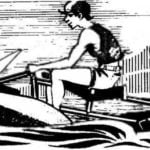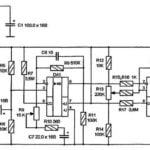 The creation of powerful airborne forces in Germany and the Soviet Union did not go unnoticed in the United States, and in February 1941, the Americans commenced their formation. And to provide the paratroopers with the support of armored vehicles, it was decided to develop a light tank weighing not more than 7.5 tonnes can be transported by air. For participation in competition were invited to the Corporation “General motors”, the famous designer George. W. Christie and company “Marmon-Herrington”. The last seemed the most appropriate, and in may 1941 she ordered a prototype light tank under the designation T9. At the same time began the development of the aircraft, able to take on Board this war machine.
The creation of powerful airborne forces in Germany and the Soviet Union did not go unnoticed in the United States, and in February 1941, the Americans commenced their formation. And to provide the paratroopers with the support of armored vehicles, it was decided to develop a light tank weighing not more than 7.5 tonnes can be transported by air. For participation in competition were invited to the Corporation “General motors”, the famous designer George. W. Christie and company “Marmon-Herrington”. The last seemed the most appropriate, and in may 1941 she ordered a prototype light tank under the designation T9. At the same time began the development of the aircraft, able to take on Board this war machine.
The first prototype had a mass of 8 tons, which, however, did not bother the air corps of the US army (aviation in the USA became an independent native troops much later) and also the British interested in the American project. Housing tank welded from rolled armor, and the double tower was a shaped casting. Suspension a suspension is used with a vertical buffer springs, adopted by all the American light tanks of the time. In January 1942 received an order for two improved sample Т9Е1. Changed the thickness of the frontal armor and the shape of the tower, the rotation which was carried out by using servo. Cannon received a gyroscopic stabilizer. Seized two machine guns, previously located in the tank hull. Clamping units allow you to hang the tank to the transport plane C-54, however, required to remove from the tank tower and load it on the plane.
In April 1942 he was ordered Т9Е1 500 tanks, although their trials have not even started. Due to various problems encountered in the production process and endless changes made to the initial draft of the planned 1900 cars produced only 830, after which production was discontinued. The army was never satisfied with the design of the tank. Recent tests conducted in September 1943 showed that the tank is unreliable, has limited mobility, insufficiently armed and armored. The military was drawn from the standardization (i.e., adopting), and only in August 1944 Т9Е1 received army designation M22. However, in both American and English army, this car was already well known under the name “locust” “Locust”.

M22 airborne tank in the exposition of the military Museum at Aberdeen proving ground in USA
With a mass of 7.4 tons and a very small overall size of this locust was armed the same as a light tank “Stuart” — MB gun caliber 37 mm and 7.62-mm machine gun Browning М1919А4. Ammunition of the tank consisted of 50 artillery rounds and 2500 rounds. The thickness of the armor plates ranged from 10 to 13 mm, and only the tower had frontal armor thickness of 25 mm. six-cylinder horizontally-opposed carbureted engine is air-cooled Lycoming 0-435Т with a capacity of 162 HP allowed the car to reach speeds of 56 km/h. Voracious engine and small fuel tanks limited the range of 180 km. All tanks were equipped with radio SCR-508.
In August 1943 at Fort Knox was formed 151-I airborne tank company, and in December of the same year, the 28th airborne tank battalion. However, the euphoria that accompanied the formation of the first tank units of the airborne troops, quickly passed. The military was disappointed in the “Locust”: being a tank, by definition, it had to combine high firepower, reliable armor protection and mobility. In practice, it often happens that the lack of one quality kompensiruet excess of the other. But the trouble lay in the fact that “locust” was deprived of all three of these important qualities.
As the Americans failed to build an airplane or glider, capable of transporting lokust without preliminary dismantling of the tower, small weight and dimensions of the tank ceased to be its benefits. As for security, the armor of the combat vehicle was so thin that it penetrated even the armor piercing bullets of 12.7 mm. And, finally, to 1944 the power of the engine of the tank was too small, but its 37 mm gun did not stand up to scrutiny.

Airborne tank M22

Layout:
1 — 37-mm gun; 2 — signal; 3 — periscope observation devices; 4 — the instrument panel; 5 — the elevating mechanism of the gun; 6 — fan; 7 — antenna; 8 — shutter; 9 — generator; 10 — starter; 11 — engine; 12 — exhaust manifold; 13 — the main clutch; 14 — box 37-mm rounds; 15 — stationary extinguisher; 16 — driver seat; 17 — transmission; 18 — control lever; 19 — differential; 20 — clutch pedal.
Therefore, as part of the U.S. army “locust” in the fighting of the Second world war was not involved, and after graduation was quickly written off. The only battle scene with their participation associated with the British army. The British received lend-lease 260 tanks of this type. However, part of the 6th airborne armored reconnaissance regiment, there was only 17 cars. At the end of 1943, in addition to the “locust” this part had sixteen “tetrarchate” with a 2-pounder cannon and four 76-mm howitzers. In addition, in the regiment there were five light tanks “Stuart I” used for training purposes. By March 1944, of the 38 heavy gliders “Hamilcar”, intended for the transportation of tanks of the 6th regiment, 23 were adapted to embed in them “locust”. However, on d-day in Normandy – 6 June 1944—, American tanks were not used, yielding the palm to the British “Tetragram”.
Combat debut “the locust” took place on 24 March 1945 during the crossing of the Rhine. The half-squadron of eight tanks from structure of the 6th regiment were landed with gliders “Hamilcar” on the right Bank of the river. In battle, however, took part not all. One tank supported the paratroopers of the 17th us airborne division, by mistake, slipped out of his landing zone. Four of the “locust” operated in conjunction with infantry 12th battalion Devonshire regiment and the paratroopers of the 6th English airborne division. No more details about this episode in the foreign press, primarily in English, is not given.
American airborne tanks served in the 6th airborne armored reconnaissance regiment until the end of 1945, when there were still two “locust”. As for the rest of the tanks in June 1945, the 21st army group of field Marshal Montgomery, there were 82 tank of this type. Mostly they were used as commander’s vehicles in parts of self-propelled anti-tank artillery. However, British and canadian gunners belonged to the “locust” more than cool, not without reason, considering that as the command post of the tank “Valentine XI” much better. A few “locust”, entered the British forces in India and Southeast Asia, most happily stood in warehouses until the end of the Second world war.
M. BARYATINSKY



